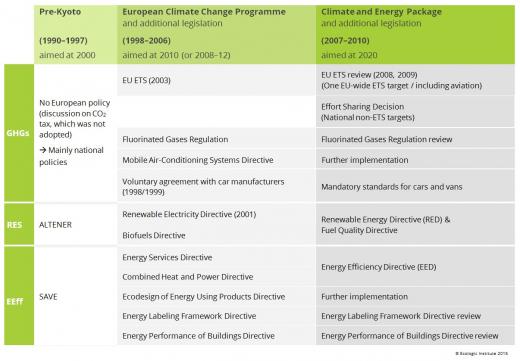Issues:
Sectors:
Keywords:
The following knowledge package focuses on the history of climate policy instruments in the European Union (EU) and is structured by stages in time. It starts with the early 1990s, and continues with the policies designed to fulfil the Kyoto targets for the first commitment period (2008-12); followed by the strategies for the second commitment period (aiming at 2020). In the end, a short introduction to post-2020 policy is provided. Detailed information on climate targets (not policy instruments) can be found in the Introduction to the Knowledge Package Overview of Climate Targets in Europe.
1. The first steps in EU climate policy
1.1 Discussions on EU climate policy triggered by IPCC report in 1990
Shortly after the release of the first summary report of the Intergovernmental Panel on Climate Change (IPCC) in 1990, climate change was first discussed by the European Council in the same year in preparation of the upcoming negotiations on the United Nation Framework Convention on Climate Change (UNFCCC). EU leaders agreed to stabilise greenhouse gas (GHG) emissions of the European Community at 1990 levels by 20001. Since it was not specified by which measures the emissions reductions were to be achieved, it triggered a discussion about common and coordinated policies and measures (PAMs). In this early process of climate policy development three main areas of climate policy were identified and addressed that are still present today: reducing GHGs, promoting renewable energy sources (RES) and improving energy efficiency (EE).
1.2 First instruments on renewable energies and energy efficiency agreed on
To tackle GHG emissions a proposal on a European CO2 and energy tax was discussed in 1992. However, there was disagreement in the Community on the need for and content of a CO2/energy tax and a group of Member States (MS) led by the United Kingdom prevented an introduction2. Despite the setback regarding CO2 taxation, softer instruments in the fields of energy efficiency and renewable energies were agreed on.
In 1991, the programme "Specific Actions for Vigorous Energy Efficiency" (SAVE)3 started to facilitate and promote the implementation of energy efficiency policies and programmes. Connected to this programme, in 1992 common standards regarding hot water boilers, household electric refrigerators, freezers and combinations were introduced4. Moreover, a labelling system for household appliances was implemented to enable the comparison of power consumption of the different models5. From 1993 on the SAVE Directive6 was in place, which required MS to limit GHG emissions by further measures such as energy audits for energy intensive companies, building certification or thermal insulation of new buildings. Nevertheless, there were no quantified targets incurred and the policy implementation could be designed by the MS.
With the ALTENER programme7 the EU introduced a Community-wide indicative target to promote renewable energies in 1993, which the MS were encouraged to include in their national policies. Renewable energies were expected to provide 8% of energy supply in 2005 and biofuels a share of 5% in the road fuel market8. Furthermore, the ALTENER programme provided funds for measures to facilitate renewable energy development, including for studies, monitoring activities and promotional and pilot actions.
With the help of a monitoring mechanism established with Decision 93/389/EEC9, the Community could assess the development of national policy programmes on the reduction of GHG (there were no MS targets) and monitor progress on the 2000 target. Although emissions were declining in the beginning of the 1990s, this was mainly due to effects resulting from the German reunification and the dash for gas in the UK instead of effective climate policies.
Detailed information on climate targets progress can be found in the Knowledge Package Overview of Climate Targets in Europe.
2. Implementation of Kyoto I
At the climate summit in Kyoto in December of 1997 the industrialised countries agreed on a set of quantitative GHG emission targets, with the European Community committing to 8% reductions of a basket of six GHGs during the commitment period 2008-2012 (compared to 1990 levels). The Kyoto Protocol (KP) installed market based mechanisms to implement the reduction targets, i.e. international emissions trading, the clean development mechanism and joint implementation.
2.1 European emissions trading scheme introduces emission caps
Except for voluntary agreements with car producers on emissions reductions in 199810 and the Landfill Directive 1999/31/EC11 to reduce methane in 1999, there was not much concrete progress regarding European climate PAMs in the late 1990s, in the direct aftermath of Kyoto. However, as a result of having to define a strategy to meet the targets, the Community entered a more dynamic phase in climate policy making at the beginning of the new millennium. In the year 2000, the European Climate Change Programme (ECCP) was launched which examined an extensive range of policy sectors and instruments with potential for reducing GHG emissions and developed common and coordinated strategies to fulfil the Kyoto targets. It led to the introduction of the European Emissions Trading Scheme (ETS)12 with national caps for emissions from power and industry sectors in each MS, as well as proposals and communications on fields such as energy labelling, or the promotion of cogeneration and biofuels. Moreover, the Renewable Electricity Directive13 introduced indicative targets on the share of renewable electricity for each MS. In addition, further legislation on biofuels and energy efficiency was adopted. Policies and measures to meet the Kyoto targets of the first commitment period were discussed between 1998 and 2006 and aimed at bringing about reductions for the period of 2008 to 2012.
2.2 European climate policies target greenhouse gases, renewable energies and energy efficiency
Table 1 gives an overview of the policies implemented before Kyoto, after Kyoto in the late 1990s and early 2000s for the first commitment period, as well as from 2007 to 2010 in preparation for the 2020 targets. The overview shows that European climate policies have been targeted at the main pillars of climate policy, namely GHG, renewable energies and energy efficiency measures since the beginning. Although with the disagreement on the CO2 tax there was no coordinated measure tackling GHG emissions in the early 1990s, the following time periods brought about various instruments in this area.
In 2004, 2007 and 2013 the European Community expanded by including 10, 2 and 1 Central and Eastern European countries respectively, which all adopted the Community’s climate policies. Except for Malta and Cyprus, all of these countries had also committed to GHG reduction targets for 2008-12 under the KP.
3. Implementation of Kyoto II
3.1 Climate and energy package continues threefold policy approach
In March 2007, EU Heads of State agreed on a set of three targets referred to as "20-20-20 by 2020"14 including a target on GHG emissions, renewable energies and energy efficiency. To implement the new targets, the European Commission introduced the "Climate and Energy Package" in 2008. This package consists of four main parts:
- a reviewed Directive on emissions trading (ETS Directive)15 with a single EU-wide cap for the 3rd allocation period (2013-20),
- the Effort-Sharing Decision (ESD)16 introducing national reduction targets for non-ETS sectors of all MS,
- the Renewable Energy Directive (RED)17 laying down national targets for use in electricity, heating/cooling and transport and
- a Directive on carbon capture and storage (CCS Directive)18. In addition, the Fuel Quality Directive19 and CO2 emission performance standards for cars20 were adopted together with the Climate and Energy Package.
Energy efficiency was not directly included in the package through specific measures, but is tackled by a great number of sector specific approaches, including taxation measures, standards and information tools. Since 2012 the Energy Efficiency Directive (EED)21 is in place as a common framework of measures for the promotion of energy efficiency (see Table 1 for an overview of the policies implemented in this time frame).
Table 1 also shows that policy instruments developed over time. Some measures evolved and built on experience with previous measures, which were reshaped or developed further, as a result of policy learning. Also the requirements of certain interest groups actively shaped and influenced the design of climate policies. Regarding GHG for example the EU ETS developed from a system with national caps for each MS towards an EU-wide cap and thereby took some control of MS over certain economic sectors out of MS' hands. In the example of renewable energies, the Renewable Electricity Directive (indicative MS targets for renewable electricity) and the Biofuels Directive merged under the Climate and Energy Package into the RED. Furthermore, the RED introduced binding national renewable energy targets as share of final energy consumption, and thus increased the legal status of the instruments and included renewable heating and cooling. However, the target framework for 2030 demonstrates that policy development does not necessarily always work towards more stringent solutions. As the 2030 renewable energy target will be introduced as only binding at EU-level, the stringency of the RED will have to be adjusted to allow Member States to choose their own indicative targets.
4. The period after 2020
In October 2014 the European Council agreed on a new target framework for 2030 using a threefold approach as for 2020. The 2030 greenhouse gas target of 40% will continue to be split into ETS (43% compared to 2005) and non-ETS sector targets (30% compared to 2005), with the non-ETS targets being binding at MS level22. The new target values for ETS and non-ETS will have to be included in legislation, which will require a reform of the ETS Directive and a new ESD dividing up the overall non-ETS goal between the Member States. In January 2014 the European Commission already presented a proposal for a reform of the EU ETS with a focus on the introduction of a market stability reserve23.
The legal status of the renewable energy target has been weakened, as the target of 27% is only binding at EU level24. Therefore, the RED will have to be adapted to match the new European target but leave out binding Member State contributions. Nevertheless, it will have to define the national target-setting process (a new element compared to the existing legislation) and revise the reporting requirements. Additionally, a mechanism to measure progress towards the target needs to be implemented and it has to be specified what follows from the identification of a gap.
The 2030 energy efficiency target will remain indicative at EU-level with targeted improvements of 27% over a baseline projection. The EED can therefore essentially stay the same regarding target notification and reporting (National Energy Efficiency Action Plans), with adaptations for the new target value. Other instruments, such as the Ecodesign Directive and Eco-Labelling, or the CO2 standards for cars may also be revised before 2020 to provide additional reductions. New policies for other sectors may be developed in the time-frame 2015-2020.

